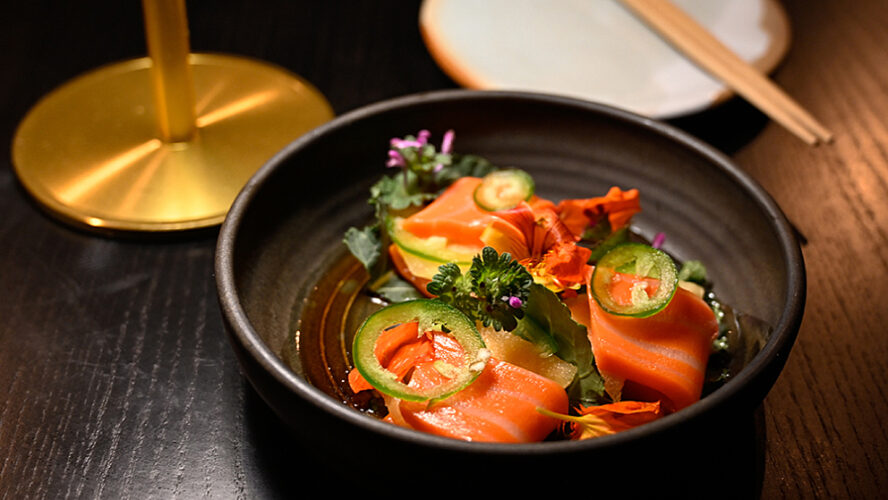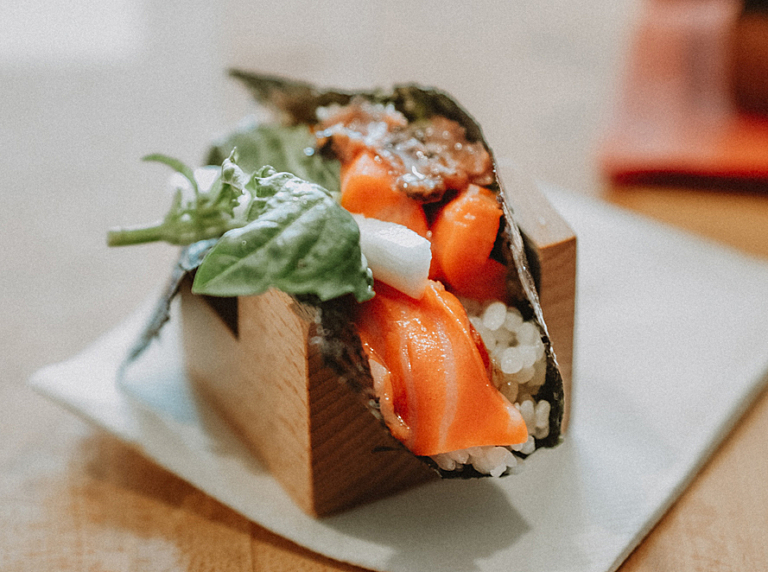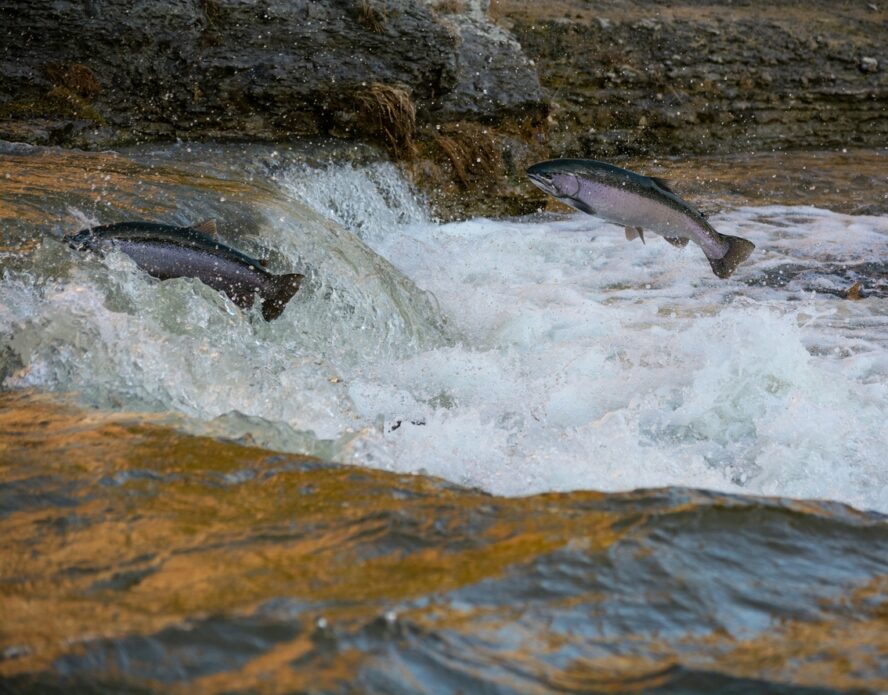FDA Approves Lab-Grown Salmon: Here’s What You Need to Know
This new lab-grown salmon is already sold in several states — but banned in several others.

There’s been a major splash in the world of ethical salmon: The FDA approved the very first lab-grown fish in late May this year. As of this month, lab-grown salmon is available in two different restaurants for American diners to try.
What Is Lab-Grown Salmon?
Lab-grown salmon, also known as cultivated salmon or cell-grown salmon, is a type of seafood produced in a lab setting with salmon cells, rather than through fishing or traditional aquaculture.
How Is Lab-Grown Salmon Made?
San Francisco’s Wildtype produces the new lab-grown salmon, which is made by harvesting living Pacific salmon cells and growing them in stainless steel tanks in a converted microbrewery.
The salmon cells are then harvested and mixed with plant-based ingredients. The final Wildtype salmon product emulates the flavor and appearance of conventional salmon so closely it’s designed to be consumed raw, sashimi-style — and all this without one life lost.
Lab-Grown Salmon Excites Eco-Conscious Chefs

Portland’s Kann became the first place to serve Wildtype’s new cell-grown salmon this spring. “At Kann, we take pride in the ingredients we utilize,” James Beard Award-winning Chef Gregory Gourdet shared in the Wildtype announcement. “Introducing Wildtype’s cultivated salmon to our menu hits the elevated and sustainable marks we want our menu to offer guests who share a similar value system to ours.”
In keeping with the Haitian accent of his menu, the chef pairs it with spiced tomato, pickled strawberries, strawberry juice, a crispy rice cracker, and epis, a Haitian pesto.
Four more restaurants will be following suit in the coming weeks, including OTOKO in Austin. Chef Yoshi Okai, who first served the salmon at the Aspen Food & Wine Classic, will be adding Wildtype to his omakase menu.
A reporter from Reason who got the chance to try the product says, “[While] the cultivated Salmon won’t fool any devoted seafood lovers, it has a pleasantly fishy, savory flavor profile—though like other lab-grown meat products, it struggles on the texture front.1”
States Are Pushing Back Against Lab-Grown Seafood and Meat
The FDA has exclusive authority over cell-cultivated seafood — but the same is not true of cell-grown meat, which must also be approved by the USDA. Three companies have already jumped through these administrative hoops: Upside Foods and Good Meat, both of which were cleared to sell cell-cultivated chicken, and Mission Barns, which has been cleared to sell cultivated pork fat.
But this new technology hasn’t convinced everyone, including consumers. Despite receiving approval in 2023, cultivated chicken fell out of fashion quickly. Today, Wildtype’s salmon is the only cell-cultivated animal protein available for sale in the U.S. Certain states are also fighting back against the approval of these products — eight states have already banned lab-grown meat, and Florida went so far as to criminalize it in 2024.
“Florida is fighting back against the global elite’s plan to force the world to eat meat grown in a petri dish or bugs to achieve their authoritarian goals,” said Florida Governor Ron DeSantis in a statement. “We will save our beef.”
The Benefits of Lab-Grown Salmon
The goal of this new product isn’t to put an end to fish as we know it. Justin Kolbeck, a Wildtype co-founder, told the Washington Post: “We’re not looking to put fishermen out of business, we are not looking to eliminate the need for fish farming.” Instead, Kolbeck explains, the goal is to reduce some of the pressure on the ocean ecosystem for this in-demand protein.
Offering a Solution to Salmon Scarcity
Salmon is the second-most popular seafood in America, with over three pounds consumed per capita in 20222. It should come as no surprise that it’s so popular, given the wealth of health benefits from its incredible omega-3 content (which have been linked to positive effects like slowed biological aging and reduced risk of breast cancer). A six-ounce filet of salmon includes somewhere between 1,700 and 4,500 mg of the healthy fatty acids, depending on the variety you purchase3.

Unfortunately, the popularity of salmon has had devastating effects on the industry and our planet. A combination of overfishing and warming rivers have led to salmon population decline and scarcity in Alaska, which has devastating effects for the earth’s biodiversity and the lifestyle of native Alaskans4. Another serious problem is bycatch, which refers to the accidental harvest of marine species other than the intended catch5.
“The amount of seafood that is currently in demand, and where it’s projected to go, are so high we actually need all of the production that we’re doing from those other tools, plus ours, plus maybe some help from the plant-based world, to be able to meet that demand,” explains Kolbeck.
Reduced Food Waste and Toxin Contamination
Scarcity isn’t the only problem that cell-grown salmon seeks to solve. Cell-cultured seafood naturally cuts down on waste, as lab-cultivated blocks of protein have no bones or scraps to contend with.
Plus, salmon grown in a lab cannot be contaminated by mercury or dangerous microplastics, which a 2024 study in Frontiers found in 99 percent of seafood samples tested6.
While salmon isn’t the biggest culprit when it comes to heavy metal contamination, with an average mercury load of .014 ppm for canned salmon (and even less on fresh varieties)7, the approval of cell-derived salmon does open the door for other lab-grown fish products that could make a massive difference. For example, BlueNalu, a San Diego-based company making cell-cultured bluefin tuna. Bluefin tuna not only accumulates high levels of mercury8 but have seen serious population decline due to demand, largely from high-end sushi markets9.
Consumers Make the Final Decision
Wildtype’s lab-grown salmon has undergone eight rounds of questioning with the FDA since 2019, so its approval was hard-won. But Sebastian Belle, president of the trade group National Aquaculture Association, remains unconvinced.
“I haven’t seen any really comprehensive life cycle analysis on the comparison of this technology to other technologies,” Belle said to the Washington Post. “At the end of the day, that’s really what we need to really understand: is it better or is it the same or is it worse? And we need to do that science.”
This FDA approval is a big step — but ultimately, it means it’s down to consumers to decide how they feel about this new culinary innovation.
Sources:
- https://reason.com/2025/06/17/lab-grown-salmon-gets-fda-approval/
- https://aboutseafood.com/education-resources/top-10-lists-for-seafood-consumption/
- https://fatty15.com/blogs/news/how-much-omega-3-in-salmon
- https://www.bbc.com/future/article/20240806-native-alaskans-facing-salmon-scarcity
- https://livingoceans.org/initiatives/salmon-farming/issues/bycatch-wild-fish-salmon-farms
- https://www.frontiersin.org/journals/toxicology/articles/10.3389/ftox.2024.1469995/full
- https://www.webmd.com/diet/mercury-in-fish
- https://www.pnas.org/doi/10.1073/pnas.2111205118
- https://www.worldwildlife.org/species/bluefin-tuna

